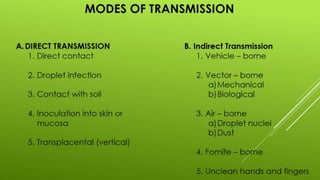List and Describe 5 Modes of Disease Transmission
Dust and fine particles known as aerosols which can float in the air can carry pathogens and facilitate the airborne transmission of disease. What are the different modes of Disease Transmission.

An Introduction To Infectious Disease Science In The News
Modes of Transmission of Diseases.

. Bookstore Shipping Interruption Starting April 1 Click to learn more. Pink eye and Ebola virus disease. If any one is missing the chain is broken and the potential for infection is eliminated.
Vehicle transmission Water milk food etc 4. Indirect Transmission- Vehicles Vectors Airborne. An infection occurs when germs enter the body increase in number and cause a reaction of the body.
Mode of Transmission of Diseases. This mechanism of transmission allows germs to be spread to many people through a single source. Insects are responsible for spreading many diseases.
Indirect transmission of an infectious agent that occurs when a vehicle or fomite touches a persons body or is ingested. A biological agent sufficient to. Terms Associated with Disease Causation Transmission Host Agent Environment Fomites Vector Carrier active Incubatory Convalescent Healthy Intermittent Modes of Transmission Direct Indirect Chain of Infection Etiological agent SourceReservoir Portal of exit Mode of transmission Portal of entry Susceptible host Forms of Disease Clinical acute sub.
As per the phrase it is understandable that this transmission occurs when blood or body fluids make contact with the bloodstream or mucous membrane of a healthy person. Another way disease-causing germs can infect you is through contaminated food and water. Understanding the modes of transmission for an infectious disease is an important way to limit its spread.
Describe how the spread of a disease would differ if the pathogen is airborne foodborne waterborne compared to a disease that requires physical contact like a handshake. These infections transfer via urine semen saliva vaginal fluids breastmilk etc. How would the results differ if you have only a 50 chance.
In this article we will discuss the topic Modes of Transmission of Diseases from the Chapter 5 Why do we fall ill out for Class 9 Science. Students learn about different kinds of disease transmission using an infographic and a reading that describe the following types of transmission. The transmission of microorganisms can be divided into the following five main routes.
Viruses bacteria parasites or fungi can spread infectious diseases. A fomite is an inanimate object that serves as a vehicle to pass an infectious disease from an. A way germs are moved to the.
How would spread differ if sexual contact was required rather than a handshake. Hantavirus is found in mouse feces urine and saliva but when these substances dry they can disintegrate into fine particles that can become. The examples of such modes of transmission are cytomegalovirus hepatitis HIV etc.
Indirect Contact Contaminated Objects. Contact transmission-direct and indirect ADVERTISEMENTS. Direct contact fomites aerosol airborne oral ingestion.
The diseases that spread from an infected person to a healthy or disease-free person are called communicable diseases. Direct Transmission- Direct Contact Direct Spread. Airborne transmission refers to diseases that can remain in the air like oxygen and water remain.
Direct indirect fecal-oral droplet airborne vector. Malaria is spread from person to person by certain species of female mosquito carrying the protozoan Plasmodium falciparum. Person-to-person spread by bodily contact.
When bacteria or viruses travel on respiratory droplets. It can be spread to humans. Contaminated objects can transmit infectious diseases.
Bubonic plague Black Death is a bacterial disease of rodents caused by Yersinia pestis. Places where infectious agents germs live eg sinks surfaces human skin Susceptible Person with a way for germs to enter the body. Animals can also.
For example someone who has the infection. An organism may have a single route of transmission or it may be transmissible by two or more routes. Direct physical contact between the skin or mucosa of an infected person and that of a susceptible individual allows direct transfer of infectious agents.
Three things are necessary for an infection to occur. HIV Typical Transmission Methods of Various Pathogens Some diseases are spread by coughing or sneezing which can cause droplets containing the infectious agent to land on nearby people. Include needles tissues toys coins and so forth.
The parasite enters the human host when an infected mosquito takes a blood meal. The mode of transmission can include direct contact droplets a vector such as a mosquito a vehicle such as food or the airborne route. Mosquitoes can carry the malaria parasite or West Nile virus and deer ticks may carry the bacterium that causes Lyme disease.
Pathogens spread from one host to another via fomites - inanimate objects inadvertently used to transfer pathogens. Consider modes of disease transmission. A disease caused by pathogens that are transmitted through the air.
Modes of Direct Transmission. For example dust particles are the dominant mode of transmission of hantavirus to humans. The susceptible host has multiple portals of entry such as the mouth or a syringe.
This is a mode of transmission for most STIs and many other infectious agents such as bacterial and viral conjunctivitis aka.

Modes Of Disease Transmission Microbiology

Modes Of Transmission From Exhaled Pathogens Adapted From Leaflet Of Download Scientific Diagram

0 Response to "List and Describe 5 Modes of Disease Transmission"
Post a Comment